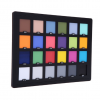Hello,
I have 5 ptz cameras and i noticed when i all point them to a single object the image looks different even though they all have the same video settings. This is bothering me and i would like to do something about it. I am satisfied that the cameras are not super color accurate, but what im particular is consistency between cameras.
Notice here its the same colored shirt but the color is different.


I was probably thinking of buying something like this. Of course its not the professional grade this one cost 20$ ,

My problem though is i dont know how to use it. I know the known values of the test colors but i have no idea how to convert them into the values needed by the camera

Anyone else encountered this problem and how you fixed it?
I have 5 ptz cameras and i noticed when i all point them to a single object the image looks different even though they all have the same video settings. This is bothering me and i would like to do something about it. I am satisfied that the cameras are not super color accurate, but what im particular is consistency between cameras.
Notice here its the same colored shirt but the color is different.


I was probably thinking of buying something like this. Of course its not the professional grade this one cost 20$ ,

My problem though is i dont know how to use it. I know the known values of the test colors but i have no idea how to convert them into the values needed by the camera

Anyone else encountered this problem and how you fixed it?



